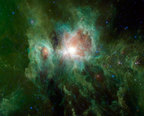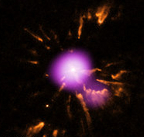Overview
The Astrophysics Science Division conducts a broad program of research in astronomy, astrophysics, and fundamental physics. Individual investigations address issues such as the nature of dark matter and dark energy, which planets outside our solar system may harbor life, and the nature of space, time, and matter at the edges of black holes.
Observing photons, particles, and gravitational waves enables researchers to probe astrophysical objects and processes. Researchers develop theoretical models, design experiments and hardware to test theories, interpret and evaluate the data, archive and disseminate the data, provide expert user support to the scientific community, and publish conclusions drawn from research. The Division also conducts education and public outreach programs about its projects and missions.
About the ASD
Seminars & Meetings
Master Calendar: Seminars & Colloquia
ASD Colloquium
Boldt Lectureship Series
Seminars & Meetings page
Links
+ ASD Annual Report
+ Visualization Explorer
+ Links
Contact Us
CAROLINE Z MASWANGANYE
301.286.8801
Secretary [660]
caroline.z.maswanganye@nasa.gov









